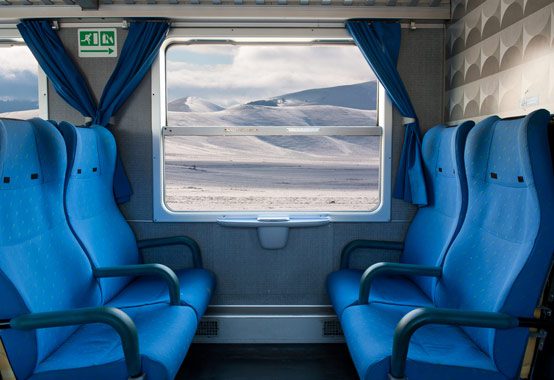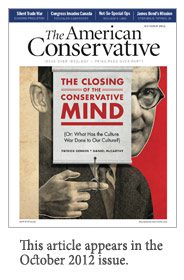The Art of Trains

It was a warm autumn day in 1996, and I was sitting on a Swiss train with a backpack full of my father-in-law’s potatoes. My wife and I had been married just a few months, and we didn’t have much money. She was finishing her last year of studies in social work, and I was teaching English-language courses in Geneva, making just enough to pay the rent, utilities, and food. I could make a good wage one month, but very little the next, depending on the number of students. This was a particularly difficult month, and we were excited about the 80 pounds of free potatoes my wife’s father had offered us. There’d be no want of potato soup, potato bread, or rösti, and the money we’d save on the staple could go towards a little extra fruit or vegetables, or maybe even some beer or ice cream.
We didn’t have a car, so I walked the six miles to my wife’s parents’ house, picked up the potatoes, and walked the three remaining miles to the station in Etoy. It seems strange to take a train for what turned out to be a little over three miles, but those potatoes were heavy. Shortly after leaving my father-in-law’s, I could feel the weight of them in my knees with each step. As I was walking, my wife’s grandparents pulled up beside me and offered me a ride, but I refused in a vain attempt to maintain a sense of self-sufficiency.
When I arrived at the station, I was exhausted, thirsty, and sore. It was a great relief to step on the régional, which would arrive in Morges after a few local stops. I hadn’t ridden on that particular train much, and I became confused about where I should get off. I grabbed my potatoes and got off at what I thought was the first stop in Morges. It wasn’t. I had gotten off at the stop before, which was at least another mile from town.
As much as I despised that mile, and the inconvenience of that day, it did nothing to cool my love of trains. If there were an occasion to regret not having a car, surely this was it, but I didn’t. I had come to love the sound of popping electrical wires and groaning metal, the stale smell of cigarettes in cabins formerly allotted to smokers, and the rhythm of the wheels on the rail joints. I memorized all the recorded announcements on the line from Morges to Geneva, which I took into work each day. These incomprehensible words (at least to me) were like magic, conjuring the beautiful Swiss countryside that seemed to change with the light.
My love of trains is at least in part a love of novelty. My father worked briefly for the metro in Seattle, but I rarely used public transportation before moving overseas. And while I had visited Switzerland before, my first year of living there was the beginning of a deeper and more nuanced understanding of the country, and my commute was a daily opportunity to observe the habits and mannerisms of these people who were both so different and not so different from myself. But it’s more than that.
To get on a train is like stepping into another world, from which the first can be viewed almost as a work of art—a transformed image of reality. The train window is the frame, and as farm houses, school children waiting for the bus, or businessmen driving to work pass in front of it, you see things as they are and as they are not. The window offers a true image of everyday life, but one cut from its original context, not by the artist but by technology. This lack of context allows you to provide your own. You can imagine the farmer’s day and his preoccupation with milk, the schoolchildren’s vague sense of worry and hope each morning, the breakfast table at the château in the distance, you can even become a part of those images yourself, entertaining possibilities suggested by them as they pass.
I remember experiencing something similar as a child, riding in the back seat of my parents’ station wagon as we drove to Spokane in the summer to visit my grandparents. It’s possible to engage reflectively with the world around you as you drive or sit in the front passenger seat, but it’s more difficult. The concentration required by driving is limiting, as is the view of the road, which is a constant reminder of reality, of your destination, whether it’s the office or a vacation home, complete with those Puritanical mile markers that remind you how far you still have to go.
Trains offer the opportunity to people-watch. There are typically two sorts of people on a train—professionals and vacationers—and both are fruitful sources for the imagination. Vacationers offer the most obvious respite from reality. With their backpacks, Italian hiking shoes, maps, and brochures, they remind you that there are millions of people not going to work. For me, this was always bittersweet, because while I could observe their excitement for the day ahead, it made the harsh reality of the workday awaiting me in Geneva seem that much harsher. I preferred watching professionals. There was something about seeing others go someplace, dressed sharply in pressed shirts and slacks, Le Temps tucked under the shoulder, that made me feel that I too was “going someplace.”
I am not one of those individuals who feels he has to choose between cars and trains, private and public transportation. I love cars. They offer a sense of freedom quite distinct from the sense of freedom trains offer. Driving a car makes you feel in control of your life. If you don’t like your destination, you can change it. If you’re tired or want a coffee, you can stop. This is, perhaps, a distinctly American sort of freedom. It is prosaic, preoccupied as it is with “plot,” whereas the freedom offered by trains is poetic, associative, largely because the destination is predetermined. There is a literary lesson here, too, about the value of formal constraints, but that’s another topic.
 Are trains more convenient than cars? I don’t know. Transfers are a pain, as is walking to the station in the rain. And while I don’t deny that trains offer at least the possibility of working and traveling at the same time, I didn’t do it as often as I had anticipated. In all my years of riding trains, it was the exception rather than the rule to see someone banging out a letter on a laptop or reading a report. Trains can be crowded, which makes them uncomfortable, and come with an assortment of smells that can be either intriguing or nauseating. They are a favorite method of suicide, especially among men, something my wife and I learned one summer returning from Bordeaux.
Are trains more convenient than cars? I don’t know. Transfers are a pain, as is walking to the station in the rain. And while I don’t deny that trains offer at least the possibility of working and traveling at the same time, I didn’t do it as often as I had anticipated. In all my years of riding trains, it was the exception rather than the rule to see someone banging out a letter on a laptop or reading a report. Trains can be crowded, which makes them uncomfortable, and come with an assortment of smells that can be either intriguing or nauseating. They are a favorite method of suicide, especially among men, something my wife and I learned one summer returning from Bordeaux.
As much as I love trains, I am skeptical about the recent push to invest in rail in America. We’ve come too far with cars, it seems to me, and it’s too late to go back. Who knows what new form of public transportation using America’s existing infrastructure might be invented in the future? But one thing I do know is that there is nothing quite like finding yourself alone on a régional, sunlight pouring into the cabin, with a moment to quietly reflect on life.
Micah Mattix is assistant professor in literature at Houston Baptist University.
Comments